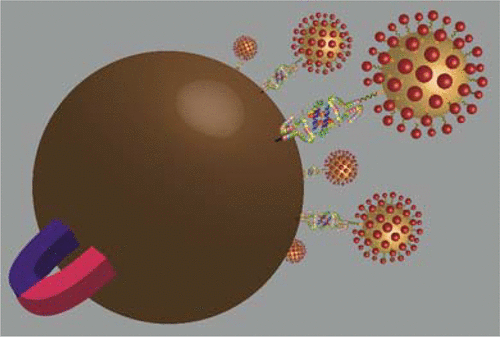当前位置:
X-MOL 学术
›
Bioconjugate Chem.
›
论文详情
Our official English website, www.x-mol.net, welcomes your
feedback! (Note: you will need to create a separate account there.)
Detection of Plasmodium Lactate Dehydrogenase Antigen in Buffer Using Aptamer-Modified Magnetic Microparticles for Capture, Oligonucleotide-Modified Quantum Dots for Detection, and Oligonucleotide-Modified Gold Nanoparticles for Signal Amplification
Bioconjugate Chemistry ( IF 4.0 ) Pub Date : 2017-08-15 00:00:00 , DOI: 10.1021/acs.bioconjchem.7b00328 Chloe Kim 1, 2 , Peter C. Searson 1, 2
Bioconjugate Chemistry ( IF 4.0 ) Pub Date : 2017-08-15 00:00:00 , DOI: 10.1021/acs.bioconjchem.7b00328 Chloe Kim 1, 2 , Peter C. Searson 1, 2
Affiliation

|
To overcome the limitations associated with antibody-based sensors, we describe a proof-of-concept of an aptamer-based sandwich assay for detection of lactate dehydrogenase, an antigen associated with malaria. We show a detection limit of Plasmodium falciparum lactate dehydrogenase and Plasmodium vivax lactate dehydrogenase of 0.5 fmole in buffer, comparable to an antibody-based assay, using a magnetic particle–aptamer construct for capture and a quantum dot–aptamer construct for detection. We then demonstrate a detection limit of 10 amole (50-fold amplification) using oligonucleotide-functionalized gold nanoparticles to allow the conjugation of multiple quantum dots for each target antigen.
中文翻译:

检测疟原虫在缓冲乳酸脱氢酶抗原使用适体改用于捕获,寡核苷酸修饰的量子点的检测,寡核苷酸修饰的金纳米粒子信号放大的磁性微粒
为了克服与基于抗体的传感器相关的局限性,我们描述了用于检测乳酸脱氢酶(一种与疟疾有关的抗原)的基于适体的夹心测定的概念验证。我们显示了在缓冲液中恶性疟原虫乳酸脱氢酶和间日疟原虫间质乳酸脱氢酶的检出限为0.5 fmole,与基于抗体的测定相当,使用磁性粒子-适体构建体进行捕获,而量子点-适体构建体进行检测。然后,我们证明了使用寡核苷酸功能化的金纳米颗粒的10摩尔(扩增50倍)的检测极限,以允许每个目标抗原的多个量子点的共轭。
更新日期:2017-08-15
中文翻译:

检测疟原虫在缓冲乳酸脱氢酶抗原使用适体改用于捕获,寡核苷酸修饰的量子点的检测,寡核苷酸修饰的金纳米粒子信号放大的磁性微粒
为了克服与基于抗体的传感器相关的局限性,我们描述了用于检测乳酸脱氢酶(一种与疟疾有关的抗原)的基于适体的夹心测定的概念验证。我们显示了在缓冲液中恶性疟原虫乳酸脱氢酶和间日疟原虫间质乳酸脱氢酶的检出限为0.5 fmole,与基于抗体的测定相当,使用磁性粒子-适体构建体进行捕获,而量子点-适体构建体进行检测。然后,我们证明了使用寡核苷酸功能化的金纳米颗粒的10摩尔(扩增50倍)的检测极限,以允许每个目标抗原的多个量子点的共轭。











































 京公网安备 11010802027423号
京公网安备 11010802027423号